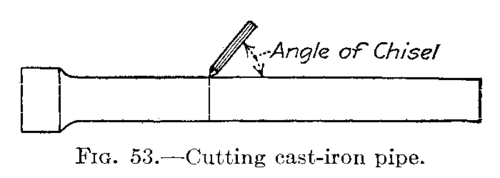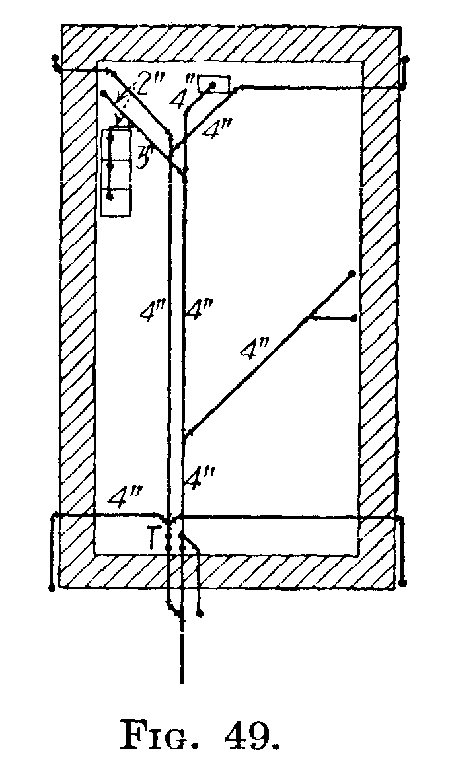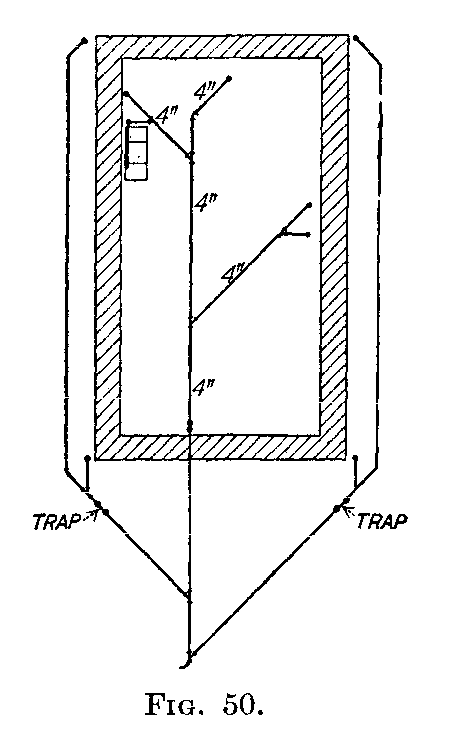Storm And Sanitary Drainage With Sewage Disposal In View. Continued
Description
This section is from the book "Elements Of Plumbing", by Samuel Edward Dibble. Also available from Amazon: ELEMENTS OF PLUMBING.
Storm And Sanitary Drainage With Sewage Disposal In View. Continued
Caulking Joint In Horizontal Position
It is necessary in a great many cases to caulk a joint in a position where the lead would run out of the joint unless provision were made to hold it in. To caulk a joint in a position of this kind, the pipe is lined up and secured, then the oakum is put in and forced to the bottom of the hub. Then a joint runner, which is an asbestos rope about 2 feet long and about 1 inch in diameter, is fitted around the pipe and forced against the hub where it is clamped by means of an attached clamp. The clamp is put on the top of the pipe and so arranged that a channel will be left in a V shape. This channel allows the hot lead to run between the asbestos runner and the hub. When the lead has had a chance to cool, the asbestos runner is taken off. Where the clamp was, there will be a triangular piece of lead sticking out beyond the face of the hub. This piece has to be cut off, but no attempt should be made to do so until it has been caulked in place and well set; also the rest of the lead should be set. Then the cold chisel can be used and this extra piece of lead taken off. The caulking of the lead in this position is the same as in the previous position and should be carried out closely. The beginner should understand that it is necessary to have not only the joints tight so that running water will not leak out of them, but that the joints must stand a water test. The testing of soil stacks is explained under another heading. The lines of cast-iron pipe depend to a considerable extent upon these joints to make the whole line rigid.
Caulking Of Fittings
The caulking of fittings, while done the same as a straight pipe, is far more difficult. The improper making of these joints is the cause of many leaks. A long sweep fitting is caulked without a great deal of difficulty. If a short bend fitting is used, the matter of caulking is difficult. The fitting is so short that it is almost impossible to get a caulking iron into the throat. The mechanics will have to work at the throat from each side until this part has been sufficiently caulked. I call attention to this point, for I know it to be a failure in a large number of jobs when it comes to put the test on. In order to caulk the fittings, they must be put in their exact location and positions before the lead is poured in, for after the lead is once in the fitting cannot be moved. When there is a series of fittings on a line, their positions in relation to each other must be considered before the lead is poured.
|
|
|
|
Fig. 48 shows the same fixture and stack connections as Fig. 46. Two 4-inch lines run through the cellar, one a sanitary drain, the other a storm drain. Each 4-inch line has an intercepting trap. On the sewer side of these traps the two lines are brought together, beyond which point the two front rain leaders connect; each of the two front leaders is trapped separately.
 Fig. 52.
Fig. 52.
Fig. 49 differs from the preceding one in only two points. First, the two front leaders are brought into the cellar and connected into the storm drain on the house side of the intercepting trap. Second, the storm and sanitary drains are connected on the outside of the building.
Fig. 50 shows the same fixtures collected into a 4-inch house drain, and the rain leaders run entirely on the outside of the building. This plan is a good one as all the storm water is kept entirely outside the building. If the storm drains are kept 5 feet away from the cellar walls (see Plumbing Code) the pipes can be of tile. Another good feature of this plan is that all the pipes under the cellar are 4-inch.
Fig. 51 is similar to Fig. 46, the difference being in the location of the floor drain and the connection of the two rear rain leaders, into the house drain.
In Fig. 52 the drains shown take the waste and storm water from the apartment building, also a building set in the rear. The leader pipes in this case are trapped on the outside of the wall. The building in the rear you will note has a separate fresh air inlet and house trap, and the house sewer is continued through the front house and connected into the house drain of the front building, on the sewer side of the intercepting trap.
These drawings should be studied carefully and the student should in each case list correctly all of the material required for the installation of these jobs.
 Fig. 53. - Cutting cast-iron pipe.
Fig. 53. - Cutting cast-iron pipe.
Cutting Cast-Iron Pipe
To cut cast-iron pipe, a sharp cold chisel and hammer are needed. The pipe is marked all around, just where it is to be cut. Then it is laid with the part of the pipe that is to be cut resting on a block of wood. A groove is cut with the hammer and chisel around the pipe. One person can turn the pipe while the other does the cutting. After a little experience one man can cut and roll the pipe alone. This groove is cut deeper and deeper until the pipe breaks apart. If standard pipe is being cut, a file is generally resorted to for cutting the groove. On account of the lightness of the pipe, a hammer and chisel will crack the pipe lengthwise. When cutting extra heavy cast-iron pipe, a good heavy blow must be struck to cause the chisel to cut into the iron. After a few cuts, the beginner will understand the weight of blow that must be struck to cut the pipe quickly.
Continue to:
 Fig. 48.
Fig. 48. Fig. 49.
Fig. 49. Fig. 50.
Fig. 50. Fig. 51.
Fig. 51.

